Key takeaways:
- Understanding the publishing process requires patience, networking, and managing expectations; setbacks can lead to growth.
- Choosing between traditional, self-publishing, and hybrid paths depends on personal goals and resources, each offering distinct advantages.
- Effective marketing involves engaging with readers, networking with fellow authors, and experimenting with creative launch strategies.
- Managing feedback constructively helps refine writing; sharing experiences fosters a sense of community and trust with readers.
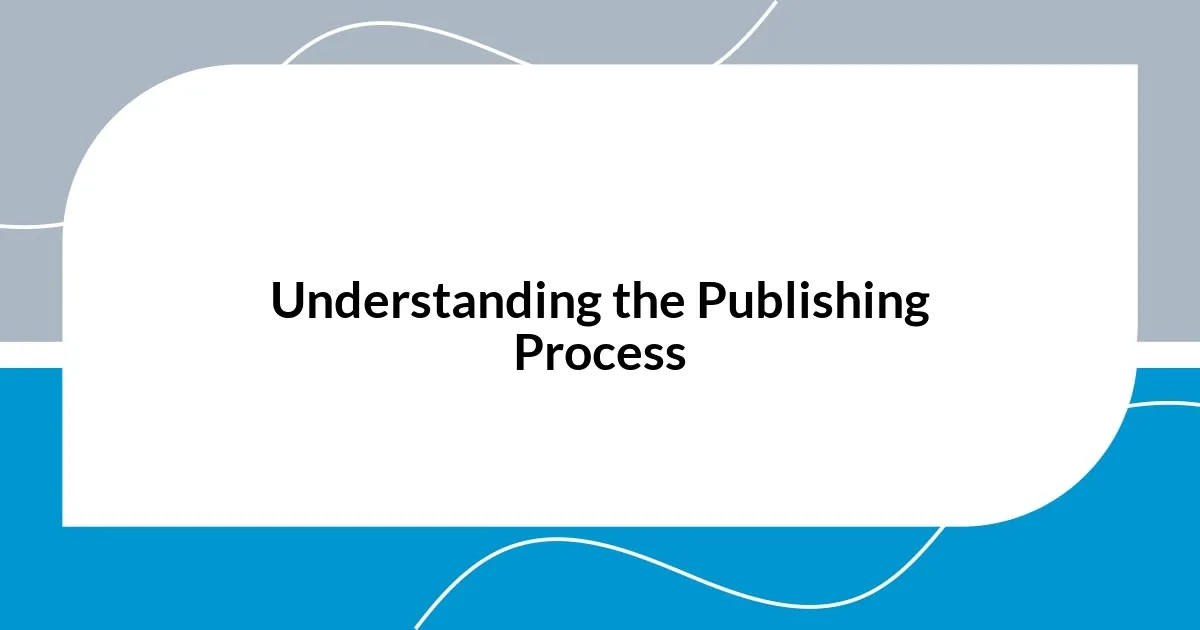
Understanding the Publishing Process
Understanding the publishing process can feel like navigating a maze. When I first embarked on my publishing journey, I was overwhelmed by the sheer number of steps involved—from drafting the manuscript to finding an agent, and ultimately, securing a publisher. Have you ever felt paralyzed by too many choices? I remember staring at my computer, constantly questioning, “Where do I even start?”
One thing I learned is that this process requires patience and resilience. Initially, I expected quick feedback and swift progress, but instead, I found myself waiting weeks for responses. It was tough to manage those feelings of uncertainty. I realized that each rejection was not a reflection of my talent but rather part of the journey. What’s your take on rejection? It’s a tough pill to swallow, but it taught me invaluable lessons about perseverance and self-belief.
As I became more familiar with how publishing works, I started to appreciate the importance of networking. I recall attending my first writers’ conference and feeling like a fish out of water. Those moments—even the uncomfortable ones—can lead to magical connections that may just open the right doors. Have you ever formed a relationship that changed your perspective on your goals? For me, it was a chance encounter with an editor that sparked not just a friendship but a collaborative opportunity I cherish to this day.
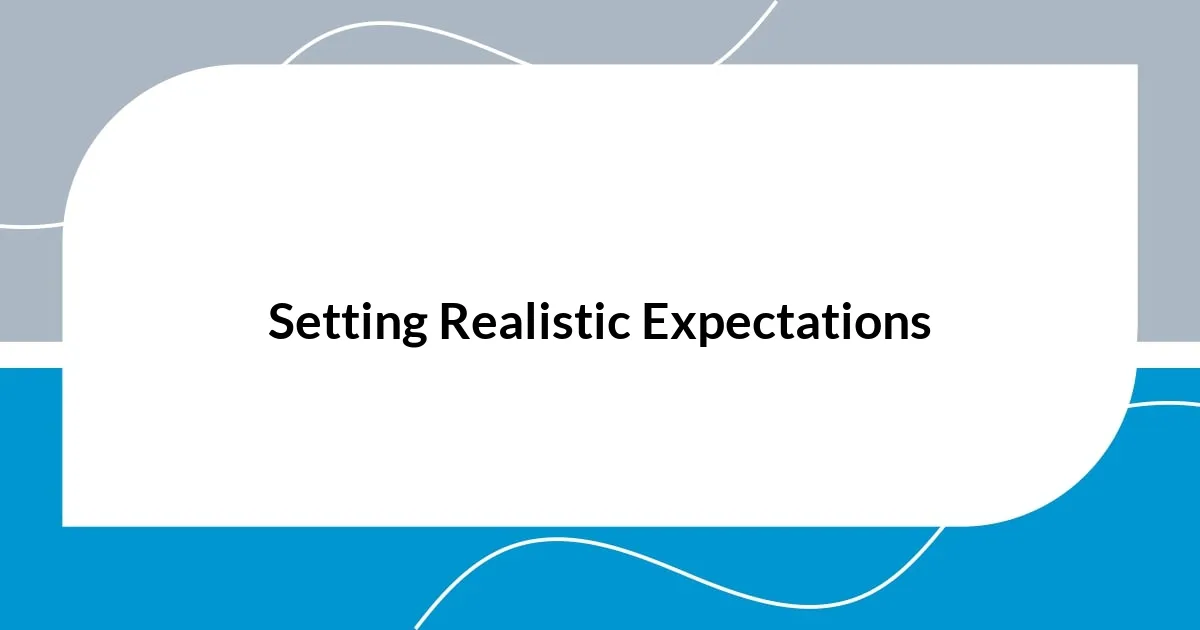
Setting Realistic Expectations
Setting realistic expectations is crucial for a smoother publishing journey. When I first envisioned my book hitting the shelves, I imagined a celebratory rush to success, only to find myself grappling with timelines, editing processes, and marketing strategies. I distinctly recall a moment of sheer frustration when a timeline I had meticulously planned went awry. It was a wake-up call that taught me to embrace flexibility—something I hadn’t anticipated.
Here are some key points to keep in mind:
- Understand that the publishing timeline can be unpredictable and varies greatly depending on many factors, including the type of publishing route you choose.
- Be prepared for constructive feedback—it’s part of the refining process, helping to strengthen your manuscript.
- Acknowledge that marketing and promotion are ongoing efforts; successful authors often invest years building their brand and visibility.
- Embrace the ups and downs of the creative process; every setback can lead to personal growth and improved writing skills.
- Connect with fellow authors and industry professionals—a supportive community can help you stay grounded during challenging times.
Recognizing these realities early on helped me navigate my own expectations more effectively. I learned to view setbacks as stepping stones rather than roadblocks. What about you? How do you manage your expectations in creative pursuits?
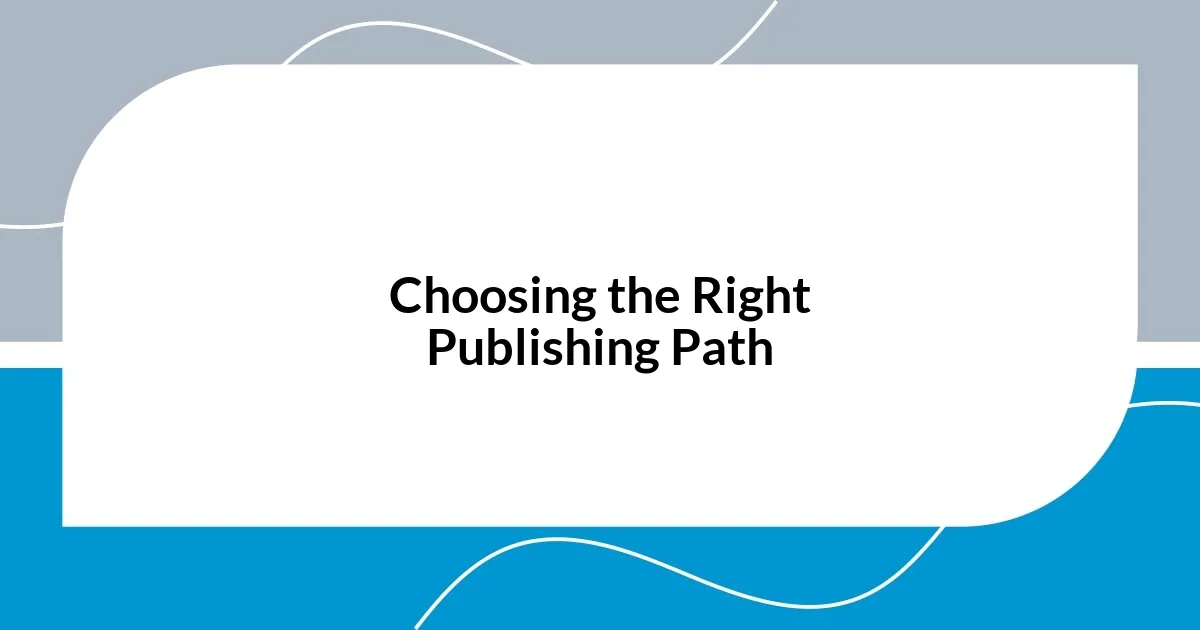
Choosing the Right Publishing Path
Choosing the right publishing path can be a daunting task, and I completely relate to that feeling. Reflecting on my experience, I discovered that understanding each option—traditional, self-publishing, and hybrid—can profoundly shape the journey of your book. For instance, I once thought traditional publishing was the only way to gain credibility, but I soon found self-publishing offered a unique level of control and creative freedom that aligned perfectly with my vision.
As I weighed my options, I realized that each path has its own set of demands and rewards. Traditional publishing often comes with rigorous editorial support but can take longer to launch your work. On the other hand, self-publishing allows you to move at your own pace, but it requires a hefty investment of time and effort in marketing and distribution. It was a balancing act for me, and I often wondered if I was making the right choice. Have you ever felt the weight of such decisions?
Ultimately, the right path for you will depend on your goals and resources. I remember attending a discussion panel where successful authors shared their journeys, revealing that there’s no one-size-fits-all solution. Some authors thrived in the traditional sphere, while others carved beautiful niches through self-publishing. Gathering insights from different experiences helped me overcome my indecision. Do you have a publishing path in mind? Your unique goal may just illuminate the best choice for you.
| Publishing Path | Pros |
|---|---|
| Traditional | Editorial support, credibility, and access to distribution channels. |
| Self-Publishing | Creative control, faster publication, and higher royalties. |
| Hybrid | Combines benefits of both, offers flexibility in choice and control. |
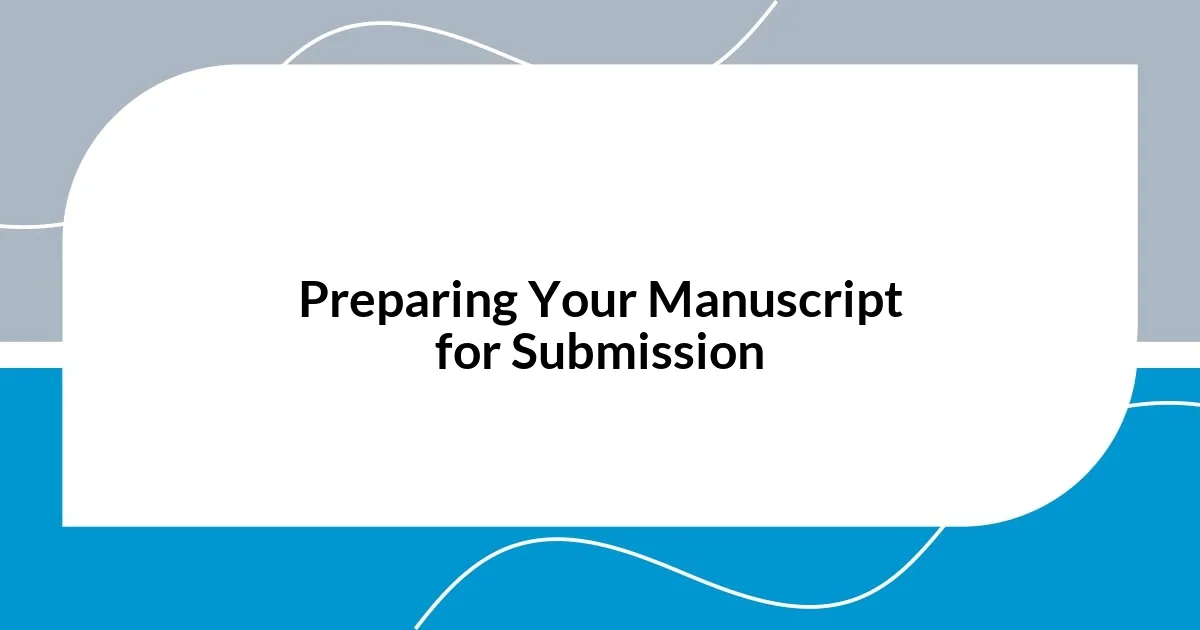
Preparing Your Manuscript for Submission
When it comes to preparing your manuscript for submission, I can’t stress enough the importance of polishing every detail. I remember nervously clicking “send” on my first submission, only to discover a glaring typo that made my stomach drop. That experience taught me the value of multiple revision rounds—have you considered the same? It’s crucial to read through your work several times and even consider having a trusted friend or fellow writer review it. Fresh eyes can catch mistakes that the author’s own gaze might overlook.
Formatting is another key aspect that often goes unnoticed. I once submitted a manuscript that didn’t comply with the publisher’s guidelines—it was a frustrating setback. To avoid this pitfall, I make it a habit to carefully check each submission guideline. Every publisher has specific requirements regarding structure, font size, and margins; adhering to these can make a world of difference in how your work is received. Have you laid the groundwork for following the specific formatting demands of your chosen path?
Lastly, don’t underestimate the power of a compelling query letter or synopsis. Crafting these additional pieces may seem tedious, but they are often the first thing an agent or publisher will see. I recall spending countless nights perfecting my own query, and the effort truly paid off. What does your query convey about your manuscript? A bright and engaging letter can spark interest before anyone even dives into your pages. Remember, the first impression is everything!
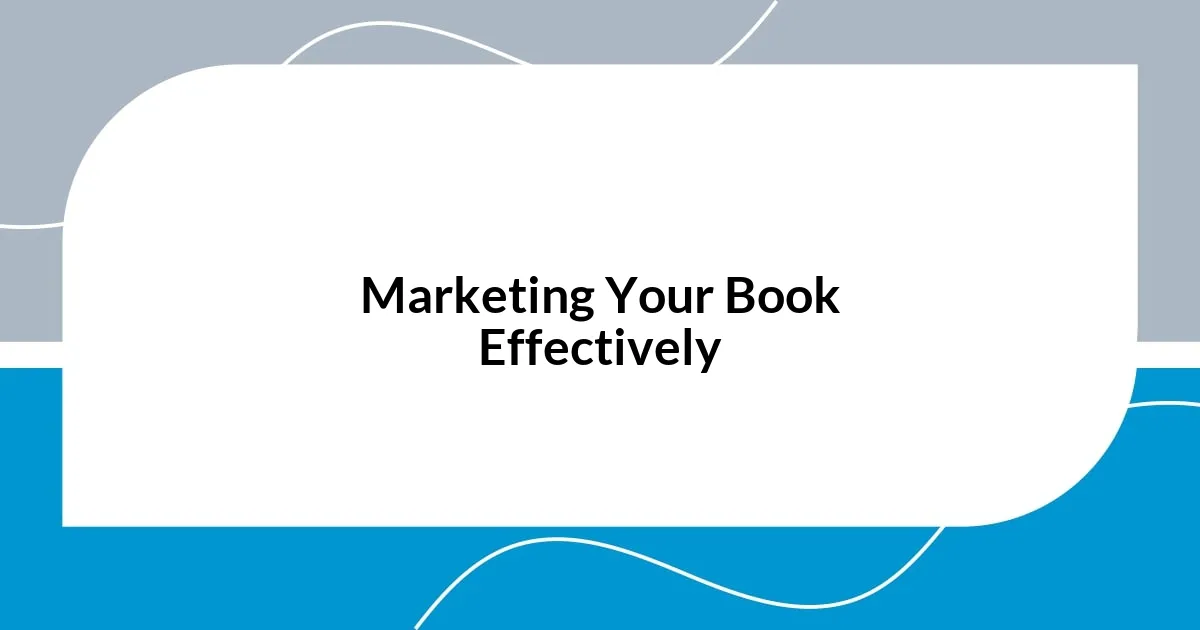
Marketing Your Book Effectively
When it comes to marketing your book effectively, I learned the hard way that simply publishing it doesn’t guarantee visibility. I remember my initial excitement after hitting that publish button, only to find my book lost in an ocean of titles. It felt disheartening. But diving deep into marketing strategies opened my eyes. Have you ever felt that sinking feeling of putting in so much effort, yet seeing little return? Engaging with readers on social media platforms like Instagram or Facebook can truly create a community around your work, making your book more than just a product.
Networking also played a crucial role in my marketing efforts, and I wish I had prioritized it sooner. I once hesitated to attend author meetups, thinking my work wasn’t polished enough. But when I finally took the plunge, the connections I made were invaluable. Recommendations and word-of-mouth from fellow authors can drive sales far more effectively than ads at times. Think about the last time you bought a book based on a friend’s recommendation—how powerful is that?
Lastly, experimenting with different marketing tactics became essential for my growth as an author. For instance, I organized a virtual book launch, which allowed me to interact directly with my readers. The excitement was palpable, and I could feel the energy of those attending! It was a memorable experience that not only boosted my sales but also helped forge stronger connections with my audience. Have you thought about ways to make your book launch engaging? Embracing creativity in your approach can lead to unexpected opportunities that enhance your journey.
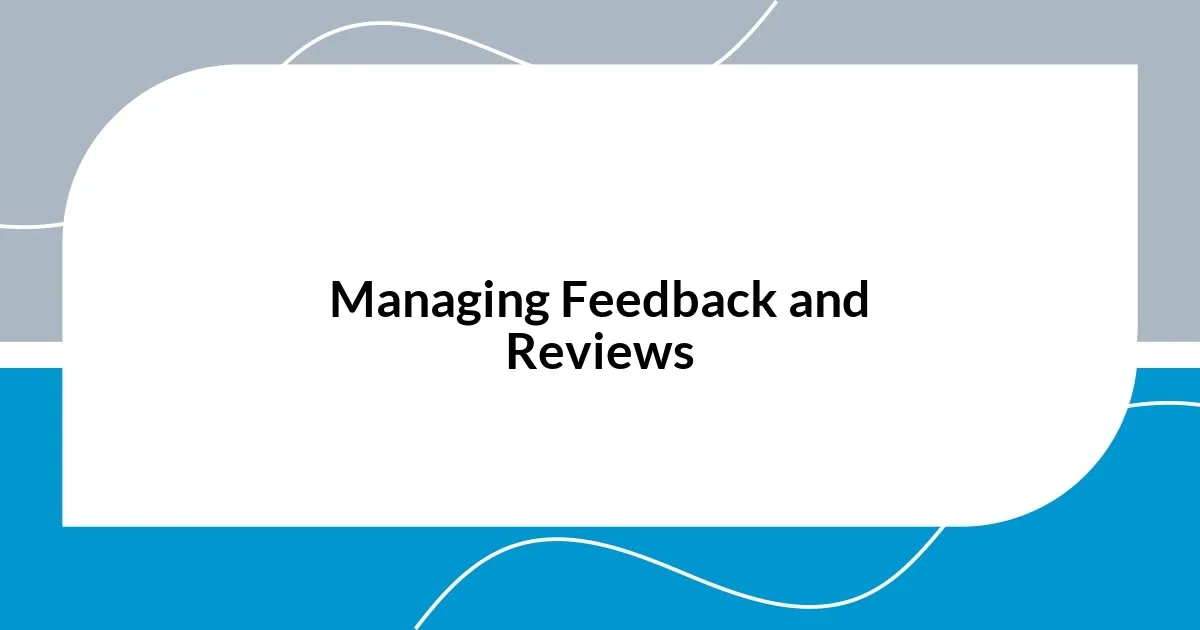
Managing Feedback and Reviews
When it comes to navigating feedback and reviews, I’ve learned that it’s essential to approach them with an open mind. I remember receiving my first negative review—it stung, and my instinct was to defend my work. But as time went on, I realized that constructive criticism offers invaluable insights. Have you ever experienced that moment when feedback actually made you rethink your approach? Sifting through reviews can enhance your writing, while also helping you connect with your audience more deeply.
It’s also crucial to remember that not all feedback will resonate or be relevant. I recall a time when a reviewer suggested a plot change that just didn’t fit my vision. Initially, I felt frustrated, but I took a step back and reassessed the comment in the context of my broader goals. It taught me that while open-mindedness is important, it’s equally vital to remain true to my creative intentions. Have you considered how to balance absorbing feedback while staying authentic to your voice?
Finally, sharing both positive and negative reviews with your readers can create a sense of community. I’ve found that candidly discussing my experiences with feedback on social media cultivates trust. It invites readers into my journey, making them feel like partners in my writing process. Isn’t it fascinating how sharing vulnerability can forge better connections? By managing your responses to feedback and being transparent, you can turn reviews into a powerful tool for growth rather than a source of anxiety.
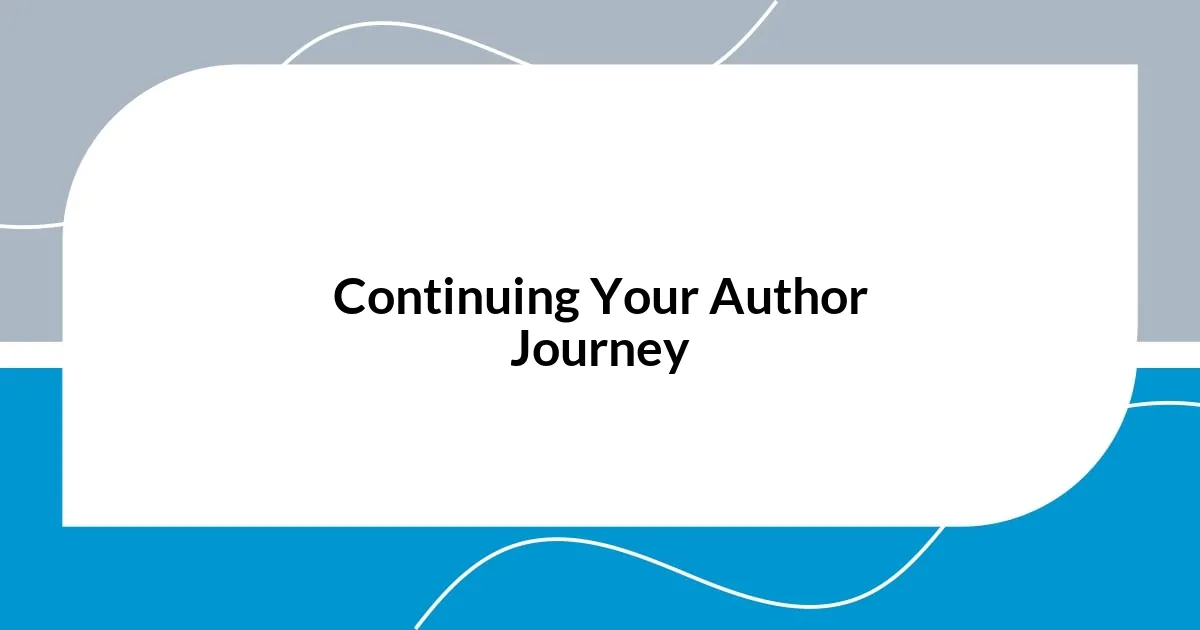
Continuing Your Author Journey
Continuing your journey as an author is not just about writing more books; it’s also about evolving as a creator. I remember when I finished my first book and naively thought my journey was over. But soon, I realized that each story written demands an introspective look at my growth and a reevaluation of my craft. Have you paused to consider how every project helps shape your writing style? The process of reflection can reveal deep insights that not only improve your writing but also enrich your overall experience as an author.
Engaging with fellow authors and readers often ignited my enthusiasm for storytelling. I vividly recall attending a writing retreat, where discussions about our works sparked new ideas and perspectives. Suddenly, my creative wellspring felt replenished! It made me realize the importance of interaction beyond just the traditional publishing path. How often do you seek out those who understand your journey? Collaborating with others can lead to unexpected inspiration and fresh ideas that propel your writing forward.
Finally, I’ve discovered that embracing change is essential in this ongoing journey. Whether it’s experimenting with new genres or exploring different formats, staying open to possibility can be exhilarating. I once dared to write a short story collection after releasing a novel, and the freedom I felt was incredible. Have you considered what new ventures might await you? Pushing your boundaries can lead to significant personal growth, and often, it’s the risks we take that yield the most rewarding experiences.